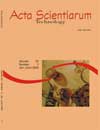<b>Non-linear analysis of reinforced concrete plates by the boundary element method and continuum damage mechanics</b> - DOI: 10.4025/actascitechnol.v31i1.348
DOI:
https://doi.org/10.4025/actascitechnol.v31i1.348Keywords:
boundary elements, damage mechanics, plate bendingAbstract
In this work, non-linear analyses of reinforced concrete plates are performed by using a BEM formulation, based on Kirchhoff´s theory, which has already proved to be a robust technique to deal with plate problems. The non-linear behavior of concrete is modeled by the Mazars model, which is based on continuum damage mechanics (CDM) and has an easy parametric identification, while the reinforcement is governed by the uniaxial elasto-plastic model with constant hardening. Initially, the different types of damage models and their parametric identification are discussed and the Mazars model is presented. Then the BEM formulation is discussed, which is based on the initial moment technique, where the remaining domain integrals are evaluated by approaching the initial moment field over internal cells. The stress distribution over the plate thickness is obtained by using a Gauss scheme in which the adopted criterion is verified in each Gauss point defined along the plate. Then, the internal values of moments are approached by numerical integrals along the plate thickness. Finally, some numerical examples of reinforced concrete plates are analyzed, where the potentiality of the Mazars model is verified despite the difficulties of the parametric identificationDownloads
Download data is not yet available.
Downloads
Published
2009-04-14
How to Cite
Fernandes, G. R., Araújo, D., & Pituba, J. J. de C. (2009). <b>Non-linear analysis of reinforced concrete plates by the boundary element method and continuum damage mechanics</b> - DOI: 10.4025/actascitechnol.v31i1.348. Acta Scientiarum. Technology, 31(1), 25–33. https://doi.org/10.4025/actascitechnol.v31i1.348
Issue
Section
Civil Engineering
License
DECLARATION OF ORIGINALITY AND COPYRIGHTS
I Declare that current article is original and has not been submitted for publication, in part or in whole, to any other national or international journal.
The copyrights belong exclusively to the authors. Published content is licensed under Creative Commons Attribution 4.0 (CC BY 4.0) guidelines, which allows sharing (copy and distribution of the material in any medium or format) and adaptation (remix, transform, and build upon the material) for any purpose, even commercially, under the terms of attribution.
Read this link for further information on how to use CC BY 4.0 properly.











8.png)




